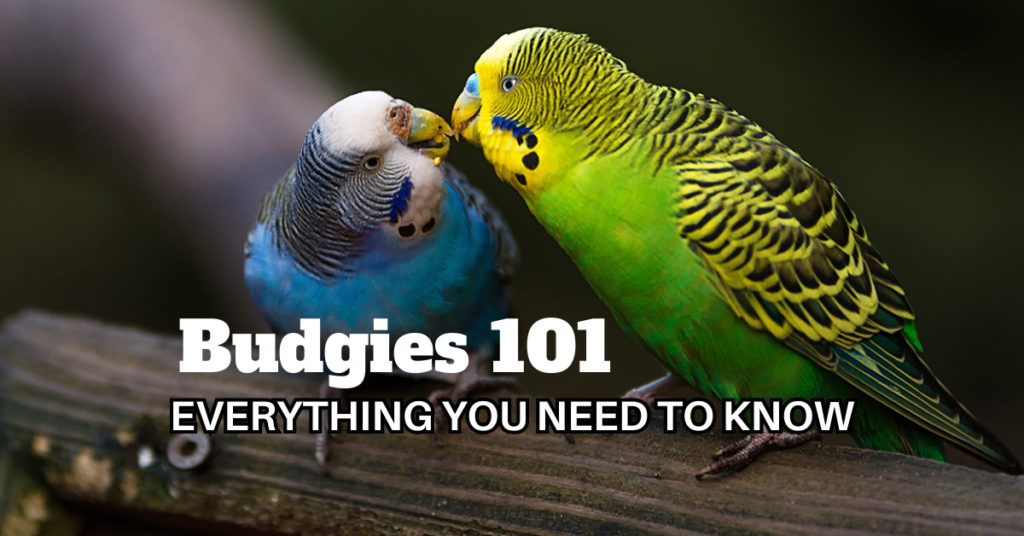Budgies, also known as budgerigars, Budgies are natives of Australia, and this is the only place where genuinely wild flocks can be found. They have been bred in captivity since the 19th century, and they are found wild throughout the drier parts of Australia, where they have survived harsh inland conditions for over five million years.
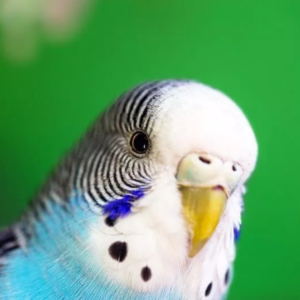
They are small parrots and one of the most popular pet birds in the world due to their playful personalities, affectionate nature, and ability to mimic human speech if appropriately trained. In the wild, they form flocks of hundreds of birds that feed and migrate together. Budgies are relatively easy to care for and can make excellent pets for first-time bird owners.
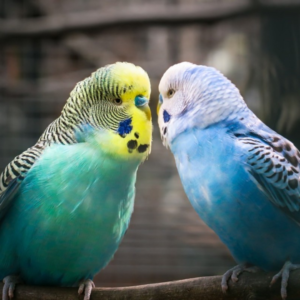
|
Kingdom
|
Animalia
|
|
Phylum
|
Chordata
|
|
Class
|
Aves
|
|
Order
|
Psittaciformes
|
|
Family
|
Psittaculdiae
|
|
Genus
|
Melopsittacus
|
|
Species
|
Melopsittacus undulatus
|
|
Niche
|
Seed-eating Tree Dweller
|
|
Length
|
Around 7 in (18 cm)
|
|
Weight
|
Just over 1 oz (30-40 g)
|
|
Lifespan
|
Typically around 8 years, though some have reached 20 years
|
|
Social Structure
|
Flocks
|
|
Conservation Status
|
Least Concern
|
|
Preferred Habitat
|
Open scrubland, woodlands, grasslands
|
|
Average Clutch Size
|
4-8 eggs
|
|
Main Prey Species
|
Grass seeds, nuts, seeds, corn, grains
|
|
Predators
|
Predatory birds, reptiles, mammals
|
Listen to Sound Recordings
Budgies make good pets because they’re intelligent, sociable, affectionate, entertaining, adorable, easy to care for, learn tricks, and can be taught to talk. They are also inexpensive and don’t need much space.
Budgies Physical Characteristics
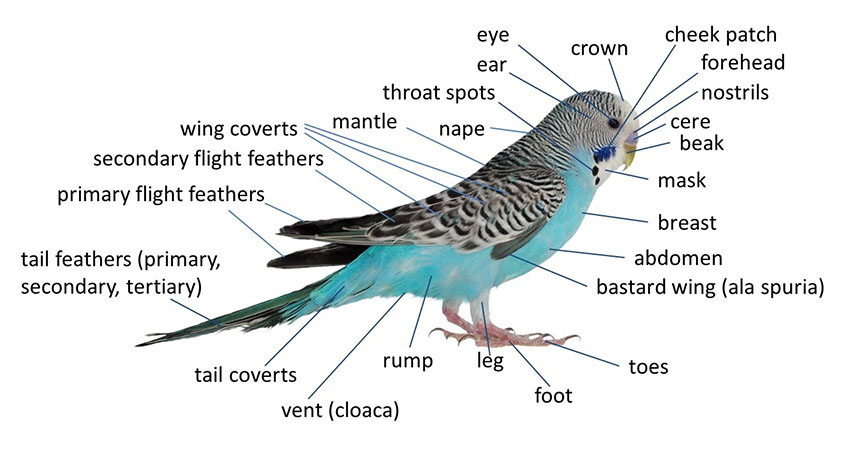
Budgerigars, sometimes called budgies, are little parrots native to Australia. They have various physical traits that influence how they view and perceive their surroundings. These birds have huge, round eyes that are located on either side of their heads, giving them a wide field of view. The average budgerigar is around seven inches long and weighs between 1.1 and 1.4 ounces. Adult budgies have yellow faces. Budgerigars have black patches on both sides of their throats. Budgies have dark blue or cobalt tails while they are upright. Common budgies’ bodies are bright green. Their mantles, which cover their backs and wings, are often yellow with black patterning.
Types Of Budgies Bird
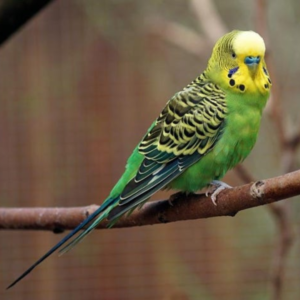
The two most common varieties of budgies sold as pets are the American budgie, sometimes known as a parakeet, and the English budgie. The American species is more commonly available in pet stores, whilst the larger English budgie is more commonly seen at exhibitions and shows. Despite their different appearances, English and American budgies are members of the same species.
Budgies come in a variety of colors, including light green, albino, sky blue, gray wing, lutino, show jumbo, and Alexander.The American species is the most common in pet stores, although the larger English budgie is frequently seen at exhibitions and displays.
How Long Do Budgies Live
Budgies have an average lifespan of 5-15 years in captivity. However, a properly cared-for budgie can live for more than ten years.In fact, in the right circumstances, they can reach 15 or even 20.The lifespan of pet budgies is heavily reliant on how well they are cared for.
How Do Budgies Behave
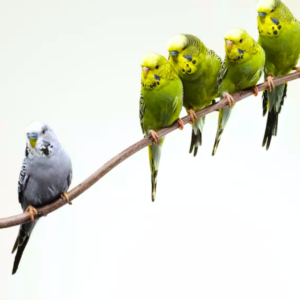
Budgies are social birds that enjoy interacting with their owners and other birds. They show extreme enthusiasm while bathing. Budgies usually enjoy each other’s company, and a pair (whatever the gender of the birds involved) will generally be a self-contained miniature flock, enjoying all the grooming, chattering, and socializing naturally to their species in the wild.
Observing budgie body language might help you comprehend their behavior. For example, when a budgie feels relaxed and pleased, its feathers puff out and it sits contentedly. On the other hand, if a budgie feels scared or anxious, its feathers will be squeezed against its body and it may move around restlessly. When your budgie is in a good mood, check for cheerful noises and vocalizations, pleasant behaviors and temperaments, and happy body language and movements.
Budgies are intelligent creatures capable of imitating different sounds and words, remembering events, and planning for the future. They can learn their name, songs, tricks, and talk. They can form long-term memories, form strong emotional bonds, and resolve problems. In fact, budgies were the first non-mammal species to demonstrate an understanding of human language.
Do Budgies Talk?
Yes, this is right. Budgies can learn to communicate more effectively than some larger parrots. They may learn their name, songs, tricks, and communicate. They can create long-term memories, build strong emotional ties, and solve issues. In fact, budgies were the first non-mammal animals to display a knowledge of human language.
Amazing Facts about Budgerigars
- Budgies have a third eyelid that is rarely visible but is essential for lubricating the eyes and keeping them free of dirt and debris.
- Budgerigars have historically been known by a variety of names around the world, including canary parrot, shell parrot, zebra parrot, warbling grass parakeet, and undulated parakeet.
- Budgies are among the most popular birds in the world, and they are arguably the most commonly kept as pets.
- Budgies live in big swarms in bushy areas and savannahs. They prefer eucalyptus trees.
- The budgie (short for budgerigar) is a parrot native to Australia. The budgie is highly intelligent and can learn to mimic human speech. In the wild,
Budgies Favourite Food
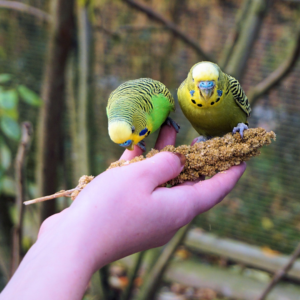
Health Concerns Of Budgies
Common health issues in budgies include respiratory infections, avian gastric yeast (AGY), avian gout, budgie candidiasis, sour crop, budgie fever (Psittacosis), goiter, and tumors. To avoid these health issues, give your budgie a well-balanced and diverse diet.
You should also avoid smooth tube-like surfaces and sandpaper-covered perches, which can cause health issues. You should also clean your budgie’s cage at least once a week.
Budgies are frequently diagnosed with avian gastric yeast (AGY) infection, avian gout, goiter/iodine deficiency, malignant tumors, psittacosis/parrot fever/chlamydiosis, budgie candidiasis, budgie sour crop, and budgie sneezing/coughing. Budgies frequently suffer from malnutrition.
Signs Of Illness In Budgies
Budgies may exhibit the following indicators of illness:
- Changing dietary habits—eating less or eating more
- Sleeping more or less than normal.
- Watery nose and eyes.
- Watery droppings.
- Feathers that are puffy, ragged, or have been reduced
- Swelling
- Bleeding
- Changes in water intake: drinking more or less.
If you suspect your budgie has a respiratory infection, take him to the veterinarian right away!To help clear the infection, your veterinarian may prescribe antibiotics, anti-inflammatory, or antifungal medications.
Conditions and Diseases Budgies Are Usually Diagnosed With
- Avian Gastric Yeast (AGY) infection
- Avian Gout
- Goiter/ Iodine Deficiency
- Cancerous tumors
- Psittacosis/Parrot Fever/Chlamydiosis
- Budgie Candidiasis
- Budgie Sour Crop
- Budgie Sneezing/Coughing.
If you suspect that your budgie has any of these diseases or conditions, it’s best to take them to a vet as soon as possible for proper diagnosis and treatment.
How To prevent your bird from falling sick
- Provide a nutritious and balanced meal rich in fresh fruits and vegetables.
- Keep their environment clean to avoid the growth of mold and bacteria.
- Make sure they always have clean, fresh water.
- Supplement their diet with healthful foods such as fresh fruits and vegetables, sprouted grains, and seeds.
- Maintain a clean cage.
- Isolate new birds for at least 42 days before introducing them to your existing birds.
How to Train Budgies
Budgies are active and intelligent birds who may be trained in a variety of tricks and behaviors. Positive reinforcement is one of the most effective methods for training your budgie. This entails rewarding your budgie with goodies or praise for engaging in a desirable activity.
One of the first tricks you can teach your budgie is to stand on your finger or a training perch. To achieve this, place your finger or the perch near the budgie and say, “Step up.” As soon as your budgie comes up, reward them and praise them.
Another skill you can teach your budgie is to step from the perch you’re holding and onto the cage perch. To perform this, follow the same commands and actions as in the “step off finger” method. To educate your budgie to return to its perch, point to it and say, “Go back to your perch.” Reward the budgie when it reaches the perch.
You can also teach your budgie “Towel Training.” Encourage physical touch by placing your hand in the cage and holding it still. Repeat this for several days to let your bird adjust to your physical presence in the cage. When the budgie appears to be comfortable with your hand, insert your finger inside the cage. Then lightly press it against your budgie’s chest. If the bird appears intimidated, simply touch its breast with the back of your finger.
How To Train Budgies To Sit On Your Finger
To educate your budgie to sit on your finger, first build trust between you and your bird by spending time with it every day, giving it treats, and speaking to it in a calm, reassuring tone. Once your budgie looks at ease with you, try offering it some food from your palm.
The next stage is to train your budgie to step up onto your finger. Hold your finger near your budgie and say, “Step up.” If your budgie steps on your finger, give it a treat. Repeat this several times per day until your budgie consistently steps onto your finger when you say “step up”.
Positive reinforcement is another method for training your budgie. Begin by getting your budgie used to seeing you near its cage. Then, hold your finger close to the cage and allow the bird to get acclimated to it. When it appears to be comfortable, try providing it with some food from your hand while holding it near the cage. When it starts taking food from you regularly, try holding the food a little further away each time until it has to step on your finger to get to it.
Budgie Cages
- The minimum cage size for a single Budgie is 18×18 inches, whereas a pair of Budgies requires 40x20x20 inches.
- Flocks require significantly larger cages.
- Perches – Budgies require perches to stand on. They should be made of natural wood and at least as long as the bird’s height.
- Budgies love toys! They require toys to keep them engaged and pleased. Swings, bells, mirrors, ladders, and other items can be considered toys.
- Food and Water Bowls – Budgies require food and water bowls that are simple to clean and refill.

